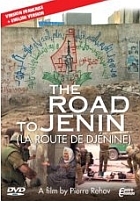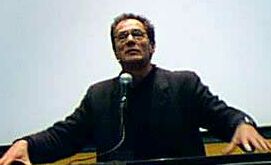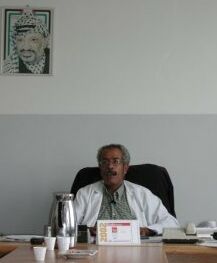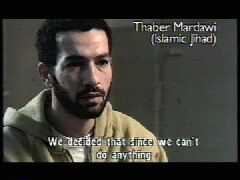Jenin, Jenin
Directed by Mohammed Bakri
Arabic with English Subtitles
54 minutes*
(*Other versions of Jenin, Jenin are reportedly 79 minutes long and 49 minutes. In the wake of criticism of the film, Bakri has admitted to shortening the film. See “Don’t Confuse Them With the Facts,” Jerusalem Post, Jan. 17, 2003).
Road to Jenin
Directed by Pierre Rehov
English, Arabic, Hebrew and French with English subtitles
52 minutes
I’m proud that justice was done and the truth came to light,” filmmaker Mohamed Bakri exulted in November 2003 when the Israeli Supreme Court reversed a ban on his controversial documentaryJenin, Jenin. “Every truth has two sides–our side and your side–and the two truths are one big truth.”
|
|
|
Mohammed Bakri |
The court’s decision overturned the Israeli Film Ratings Board’s ban, which had been imposed in response to criticism that the film was rife with false, propagandistic charges about Israeli actions during the army’s April 2002 incursion into the Jenin refugee camp.
It might comfort some to agree with Bakri that conflicting information can be reconciled as constituting “one big truth.” But is there any validity to the notion that neither side was wrong or deceptive in the case of Jenin, Jenin?
First, what were the conflicting claims? Bakri charges Israel committed genocide in Jenin, killing untold numbers of civilians, randomly executing and bombing women, children and the mentally and physically impaired, and completely leveling the entire refugee camp, including a hospital wing. The diametrically opposed view, as represented in another documentary, Road to Jenin by French director Pierre Rehov, depicts a moral Israeli army fighting a just war against armed Palestinians in a hotbed of terrorism which spawned more than half the suicide bombings against Israeli civilians. Among the terrorists from Jenin, for instance, was the killer who took 29 lives in the Passover bombing of the Park Hotel days before.
In Bakri’s version, Israel attacked Jenin residents with tanks, planes and snipers. In Rehov’s, Israel initially took the dangerous step of sending infantry to fight house-to-house so as to minimize civilian casualties. After nearly two dozen of their own men were lost to ambushes, Palestinian snipers, and booby-trapped houses, Israel brought in bulldozers for use in a limited area, a step which led to the surrender of the Palestinian fighters. (No air attacks were involved.) Can these disparate accounts–both in terms of the facts of the specific incidents they describe, as well the bigger pictures they represent–be reconciled?
Among the most disputed and misrepresented facts about the fighting in Jenin was the number of Palestinians killed and the extent of the destruction. Initially, Palestinian officials claimed that hundreds were killed in the “Jenin massacre.” For example, then Palestinian Authority Minister of Local Government Saeb Erekat stated on CNN April 10, one week into the eight day operation: “I’m afraid to say that the number of Palestinian dead in the Israeli attacks have reached more than 500 now.” (See CAMERA On Campus Fall 2002 for an in-depth review of PA misinformation.) Later, when international workers investigated the camp and found no evidence of a massacre, Palestinian officials drastically lowered the death toll to 56, a number consistent with what Israel had estimated (Washington Times, May 1).
Bakri does not address this controversy at all, nor does his film ever provide a number for the Palestinians he believed died in the assault. It does, however, continue to propagate the discredited myth that a massacre of civilians occurred at the camp. A young Palestinian girl who appears frequently throughout the film claims: “Everywhere in the camp you find someone looking for a relative, looking for their home, or a missing body.” Another interviewee states, as he is pictured with two of his young children: “The genocide they committed in our camp shows that they [the Jews] are not human. They did not leave one single building standing. They demolished everything over the inhabitants–my family, the children, the elderly.” (In fact, many standing buildings are seen in the film.) Later in the film, the interviewee avers: “They underestimate the number of victims. They should search better under the rubble to get the real number.”
The filmmaker’s photographic techniques reinforce the massacre myth. For instance, a scene of a tank heading towards a crowd blacks out, falsely suggesting that the people were all killed. Also, Bakri who, according to Israeli critic Dr. David Zangen, was not on scene during the battle to get footage, deceptively juxtaposes images of Israeli tanks and snipers taking aim with pictures of Palestinian children (Ma’ariv, Nov. 8, 2002).
Even casual observers will notice apparent inconsistencies in the “witness testimony” on which Bakri relies. For example, an older interviewee charges that the Israelis made Palestinian prisoners fully undress: “Some people were completely undressed in front of their brothers, sisters and children, who were used as human shields.” Yet, the accompanying image does not support this claim; it shows a group of Palestinians, some of them without shirts. All wore pants.
In another inconsistent episode, the younger male interviewee who had said that Jews are not human pushes his children in their double stroller into an empty tent marked “U.N.,” and announces “We’re home,” as if they were living there. Yet, not a single personal item sits in the completely barren tent. Moreover, shots of row after row of identical U.N.-issued shelters are likewise completely devoid of any signs of life–no clothes hanging out, no people milling around, no garbage on the ground. There was no indication that any dispossessed Palestinians had sought refuge there. Indeed, as theWashington Times reported: “Families whose homes had been destroyed were ordered [by Palestinian officials] to sit and lie inside tents pitched near the destruction, to be available for interviews and filming with foreign reporters and photographers. At dusk, with the press opportunities concluded, they returned to houses offered to them in the undamaged city or in the rest of the refugee camp.”
Especially inflammatory was a charge by the director of the hospital in Jenin that Israeli tanks fired 11 missiles at the facility, destroying oxygen bottles, water tubes, sewage pipes, hospital wards, doctors’ rooms and an infirmary. “The whole of the west wing was destroyed,” he testifies. “Fighter planes launched their missiles every three minutes.” Yet, the only sign of any damage to the building is a piece of glass falling out of a window.
While the casual viewer may suspect that hospital manager Dr. Mustafa Abu Gali isn’t being entirely forthright, the extent of his deception becomes apparent in Rehov’s Road to Jenin, in which Abu Gali is also interviewed. In that film, the hospital director shows the alleged damage as a result of 11 shells–a tiny hole or scratch on the outside of a building. Moreover, Rehov provides aerial images of the hospital on the last day of the incursion–surrounding trees, the roof and floors are all intact.
|
|
|
Jenin Hospital Director Mustafa Abu Ghali, who features prominently in both Jenin, Jenin and Road to Jenin, falsely charged that Israel destroyed the hospital's west wing. |
Also, in Road to Jenin, Abu Gali claims that the Israeli army prevented all ambulances from reaching the hospital, insisting: “They didn’t want people to get medical treatment.” Again, the images show otherwise: Ambulances unload casualties by the hospital doors and IDF soldiers are seeing assisting children and the elderly to reach treatment. Dr. David Zangen, the army’s chief medical officer in Jenin during the incursion, and Bakri’s leading critic, describes how the soldiers even treated Palestinian fighters, including members of Hamas. Finally, in Road, Abu Gali recounts that the 500 hospital occupants–“wounded, sick, our team, mothers and children . . . we had no food left.” Then Rehov cuts to a scene of an Israeli authorizing Abu Gali in person to receive anything he’d like for the hospital, all except weapons.
Another contentious episode touched on in both documentaries is the case of an older man with a wounded hand. In Bakri’s Jenin, Jenin, the man describes snipers shooting him in the hand from 1.5 meters away causing him to fall to the ground. The Israelis allegedly ordered him to get up and when he couldn’t, shot him in the foot. In Rehov’s film, Ali Youssef, whose name we learn, gives basically the same story.
Armed with hospital documents, Zangen then drops the bombshell: Ali Youssef had been in the same building as Hamas fighters, when he was wounded by ricocheting bullets. The Israelis took the man to an army post for treatment, where they discovered he had congenital heart failure. Ali Youssef was then treated for this condition with medical care in Afula, Israel. Hospital papers from Afula reveal that he was not shot in the leg at all.
Going on Bakri’s assumption that “[e]very truth has two sides–our side and your side,” what is one to make of the Ali Youssef incident? On one “side,” a sniper is said to have shot him in the hand, threatened him, and shot him in the foot. On the other “side,” a bullet ricocheted into Ali Youssef’s hand, the Israelis treated his wound, found a congenital heart problem, no foot injury, and brought him to Israel for treatment. The latter account is bolstered by medical documentation, while the first is based solely on Ali Youssef’s word. These disparate accounts are hardly two sides “to one big truth.”
According to Rehov, Ali Youssef’s fabrication is not an anomaly in Palestinian allegations of Israeli atrocities in Jenin and elsewhere. As international journalists made their rounds in the Jenin wreckage, residents often staged moving photographs: An old woman, sitting in the rubble, is coached: “Look at the camera. Look sad. Put your hand on your face to look desperate.”
Underscoring the Palestinian penchant for inventing “news,” Rehov even manages to capture on film the manufacturing of a fictitious news story. On Jan. 25, 2003, he accompanies Palestinian journalist Ali Smoddi of the PA-controlled Jenin television station as he and his crew set out to interview a Palestinian man and his wife whose baby was just delivered by a doctor. In the car on the way there, Smoddi constructs a fictitious story in which the husband was forced to deliver the baby: “I want to emphasize certain elements. The husband has no experience in delivering and in spite of that he’s the one who delivers his wife. It’s the climax of all tragedy.” Smoddi then takes a call from the couple’s doctor, and asks: “You’re the one who delivered her? . . . No, don’t let them go.”
At the hospital, Smoddi’s crew does several “takes” of the father’s account of the birth, each with a different spin. In one version, the father claims that the ambulance they intended to meet was held up at a checkpoint for 15 minutes, and he was forced to deliver his infant son in the car, as the ambulance had not arrived. In another telling, the father says: “The soldiers took me down to the ambulance to check my identification and my wife gave birth in the ambulance and went to the hospital.” In each account, Smoddi prompts the father and makes suggestions about the events. Smoddi then prompts the new mother: “The tank stops you while giving birth. You’re alone in the car, talk about your feelings.”
In a private communication with CAMERA, Rehov revealed that he was able to get such footage because as a journalist with a French passport, he was considered a friend of the Palestinians. Born in Algeria, Rehov understood enough Arabic to know that an event was being staged for his benefit.
Rehov also interviews Thaber Mardawi, an Islamic Jihad fighter in Israeli custody, who states: “I don’t know why they [the Israel Defense Forces] sent the infantry [into Jenin]. They knew they would be killed. To see a soldier pass in front of me, I’ve waited for this many years.” He also discusses the kinds of explosives that the Jenin fighters used against the Israelis. (In contrast, Bakri includes only oblique references to armed Palestinians, which serves his agenda of portraying a U.S.-backed Israeli military force allegedly attacking an innocent population in a massacre worse than Vietnam.)
|
|
|
In Road to Jenin, Thaber Mardawi Islamic Jihad fighter discusses the explosives that Palestinians used against Israelis in Jenin. |
Road to Jenini ncludes other revealing testimony. Australian Christian humanitarian volunteer Dalry Jones, who had initially been duped by Palestinian propaganda about Israeli action in Jenin, recounts how Palestinians displayed photos of bodies, “gouged and pitted, torn. We were told this is from torture from the Israelis.” Later, when she saw a Palestinian child blow up in front of her face, she realized that the ripped apart bodies were the result of human booby traps that the Palestinians used against the Israelis.
Rehov’s clear purpose is to expose the inflammatory–and defamatory–falsehoods spread by works like Jenin, Jenin. As such his film does not attempt to be an overview of the Israeli and Palestinian experience in Jenin or an exhaustive account of IDF conduct.
Nevertheless, the information that Rehov does provide is based on interviewees who use bona fide images and documents to substantiate their claims. In contrast, Bakri’s blatant use of lies and deception to build his one-sided case about Palestinian suffering at the hands of brutal Israel disqualifies it from having contributed to any “big truth.” Rather, as Zangen asserts, Jenin, Jeninamounts to incitement fueling vicious propaganda that claims Jews “are not even human.”
by Tamar Sternthal





